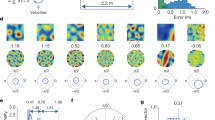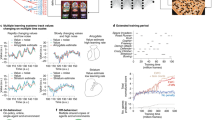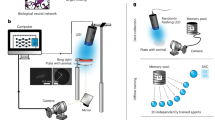Abstract
Despite the recent advancements and popularity of deep learning that has resulted from the advent of numerous industrial applications, artificial neural networks (ANNs) still lack crucial features from their biological counterparts that could improve their performance and their potential to advance our understanding of how the brain works. One avenue that has been proposed to change this is to strengthen the interaction between artificial intelligence (AI) research and neuroscience. Since their historical beginnings, ANNs and AI, in general, have developed in close alignment with both neuroscience and psychology. In addition to deep learning, reinforcement learning (RL) is another approach that is strongly linked to AI and neuroscience to understand how learning is implemented in the brain. In a recently published article, Botvinick et al. (Neuron, 107:603–616, 2020) explain why deep reinforcement learning (DRL) is important for neuroscience as a framework to study learning, representations and decision making. Here, I summarise Botvinick et al.’s main arguments and frame them in the context of the study of learning, memory and spatial navigation. I believe that applying this approach to study spatial navigation can provide useful insights for the understanding of how the brain builds, processes and stores representations of the outside world to extract knowledge.

Similar content being viewed by others
References
Arbib MA (2020) From spatial navigation via visual construction to episodic memory and imagination. Biol Cybern 114:139–167
Banino A, Barry C, Uria B, Blundell C, Lillicrap T, Mirowski P et al (2018) Vector-based navigation using grid-like representations in artificial agents. Nature 26:429–433
Benjamin L, Thomas PJ, Fellous JM (2020) A renewed vision for biological cybernetics. Biol Cybern 114:315–316
Bermudez-Contreras E, Chekhov S, Sun J, Tarnowsky J, McNaughton BL, Mohajerani MH (2018) High-performance, inexpensive setup for simultaneous multisite recording of electrophysiological signals and mesoscale voltage imaging in the mouse cortex. Neurophotonics 5:1
Bermudez Contreras E, Clark BJ, Wilber A (2020) The neuroscience of spatial navigation and the relationship to artificial intelligence. Front Comput Neurosci 14:1–16
Botvinick M, Wang JX, Dabney W, Miller KJ, Kurth-Nelson Z (2020) Deep reinforcement learning and its neuroscientific implications. Neuron 107:603–616
Buzsáki G, Moser EI (2013) Memory, navigation and theta rhythm in the hippocampal-entorhinal system. Nat Neurosci 16:130–138
Campbell MG, Ocko SA, Mallory CS, Low IIC, Ganguli S, Giocomo LM (2018) Principles governing the integration of landmark and self-motion cues in entorhinal cortical codes for navigation. Nat Neurosci 21:1096–1106
Cazé R, Khamassi M, Aubin L, Girard B (2018) Hippocampal replays under the scrutiny of reinforcement learning models. J Neurophysiol 120:2877–2896
Cueva CJ, Wei X-X (2018) Emergence of grid-like representations by training recurrent neural networks to perform spatial localization. In: International conference on learning representations (ICLR), pp 1–19
Dabney W, Kurth-Nelson Z, Uchida N, Starkweather CK, Hassabis D, Munos R et al (2020) A distributional code for value in dopamine-based reinforcement learning. Nature 577:671–675
Fellous JM, Dominey P, Weitzenfeld A (2020) Complex spatial navigation in animals, computational models and neuro-inspired robots. Biol Cybern 114:137–138
Kanitscheider I, Fiete I (2017) Training recurrent networks to generate hypotheses about how the brain solves hard navigation problems. In: Advances in neural information processing Systems (NIPS), pp 4530–4539
Momennejad I, Otto AR, Daw ND, Norman KA (2018) Offline replay supports planning in human reinforcement learning. Elife 7:1–25
Richards B, Lillicrap TP, Beaudoin P, Bengio Y, Bogacz R, Christensen A et al (2019) A deep learning framework for neuroscience. Nat Neurosci 22:1761–1770
Shepard SV (ed) (2017) The wiley handbook of evolutionary neuroscience. Wiley Blackwell, Chichester, West Sussex
Song HF, Yang GR, Wang XJ (2017) Reward-based training of recurrent neural networks for cognitive and value-based tasks. Elife 6:1–24
Sorscher B, Mel GC, Ganguli S, Ocko SA (2019) A unified theory for the origin of grid cells through the lens of pattern formation. In: Advances in neural information processing systems (NeurIPS) (Vancouver, Canada), pp 1–11
Sutton RS, Barto AG (2018) Reinforcement learning. an introduction, vol 2. MIT Press, Cambridge
Wang JX, Kurth-Nelson Z, Kumaran D, Tirumala D, Soyer H, Leibo JZ et al (2018) Prefrontal cortex as a meta-reinforcement learning system. Nat Neurosci 21:860–868
Yamins DLK, DiCarlo JJ (2016) Using goal-driven deep learning models to understand sensory cortex. Nat Neurosci 19:356–365
Author information
Authors and Affiliations
Corresponding author
Additional information
Communicated by Jean-Marc Fellous.
Rights and permissions
About this article
Cite this article
Bermudez-Contreras, E. Deep reinforcement learning to study spatial navigation, learning and memory in artificial and biological agents. Biol Cybern 115, 131–134 (2021). https://doi.org/10.1007/s00422-021-00862-0
Received:
Accepted:
Published:
Issue Date:
DOI: https://doi.org/10.1007/s00422-021-00862-0




